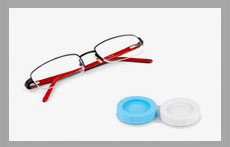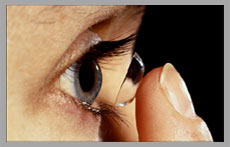


GENERAL TIPS FOR CONTACT LENS WEARERS
Which way is the Right way? How can I tell if my contact lens is inside out?
Make sure it looks like half a ball, not a soup bowl with a rim.Some contact lenses also have a brand name marked, on the edge to help you. If you can read it properly, the lens is not inside out.
Proper Contact Lens Care
- Remove contact lenses before eye contact with water
Contact lenses should remove prior to swimming, showering or bathing. - Wash hands before handling lenses
Hands should be washed thoroughly with soap - Wash hands before handling lenses
Hands should be washed thoroughly with soap
Hands should be dried well before touching contact lenses. - Clean contact lenses
Contact lenses should be properly cleaned according to the instructions. - Disinfect contact lenses
Proper disinfectant should be used to disinfect lenses; plain saline or rewetting drops are not disinfectants because they don’t kill bacteria. - Use fresh products
Each time you place your lenses in the case, or rinse them with solution, use fresh cleaning or disinfecting products. - Discard used solution
Throw out solution. Never reuse it or top it off with fresh solution. - Store contacts in lens cases
Contact lenses should always be stored in a clean and disinfected case. - Keep lens cases clean and dry
Storage cases should be irrigated with sterile contact lens solution (not tap water), and left open to dry after each use to reduce the risk of water-loving bacteria taking up residence. They should be replaced every three months, at least. - Replace contacts regularly
Contact lenses should be replaced when their scheduled wear time is up - Have regular eye exams
Regular eye examinations should be scheduled to check prescriptions and detect early signs of infection or disease. - Replace contact lens storage case regularly
Contact lens cases can encourage bacteria growth if not cared for properly. Lens cases should be kept clean and replaced every 3 to 6 months. Inexpensive cases, or the ones included with contact lens care kits, are safe and sufficient. - Care of contact lens case
After removing your contact lenses, empty the case and rinse with fresh contact lens solution (never tap water). Cases should be cleaned after each use. Always allow the lens case to air dry. If the contact lens case gets cracked or damaged, discard it and replace it with a new one. - Colored contact lenses tips
Colored contact lenses are not cosmetics, but are medical devices that require as much responsibility as regular contact lenses. Be sure to follow your doctor’s recommendations for care of your contact lenses. Also, never share contacts or makeup. Problems of contact lens storage in plain water
Contact lenses should never be stored in tap water, nor should they be rinsed with tap water. Tap water often contains microorganisms that can latch onto the lenses, encouraging eye infections. Studies have shown that an organism called acanthamoeba is sometimes found in tap water. Acanthamoeba has been known to cause a devastating eye infection that can destroy the cornea, and sometimes the entire eye. Always use a contact lens solution for storing your contacts.
Warning signals for contact lenses
If you have any pain, burning, redness, tearing or sensitivity to light while wearing any type of contact lenses, see your eye care professional immediately.Contact lens drops
Contact lens eye drops lubricate your eye and hydrate the contact lens, making your eyes more comfortable while wearing your contact lenses. Theses eye drops are labeled “For use with soft contact lenses”. Your doctor or optometerist usually encourage frequent use of re-wetting drops, as it improves comfort and helps clear out debris underneath your contact lenses.
- Wear eyeglasses when possible
Allergens such as pollen and dust often adhere to the thin surfaces of contacts. Switching to glasses will help you avoid an allergy attack - Clean contacts frequently
Cleaning will keep your contacts free of allergens. Consider using a preservative-free solution, to help avoid possible allergic reactions. If you wear disposable lenses, consider replacing them more often. - Keep eyes moist
Allergens tend to cause dry eyes. Keep irritated eyes moist with artificial tears. The artificial tears will also wash the irritants out of your eyes. - Use cool compresses
When your eyes are red and swollen, resist the urge to rub them. Rubbing will make the inflammation worse by spreading around the allergens. A cool, damp compress will help relieve discomfort. - Consult eye specialist
Your eye doctor will recommend medical products for your particular symptoms. Some products may even help prevent allergy attacks. You should also see your eye doctor to rule out possible problems that may not be allergy-related.
Decorative contact lenses tips
- Have a detailed checkup by a eye care professional. An eye doctor will be able to perform a contact lens evaluation to make sure the lenses fit well and it is safe for you to wear them.
- Purchase special effect contact lenses from your local eye care professional. Optometrists & ophthalmologists are licensed to dispense contact lenses and obtain them from reliable, well-recognized sources.
- Do not purchase them at convenience stores or beauty supply stores.
- Do not swim or sleep in decorative contact lenses.
- Do not share or swap them with friends.
- Always clean and disinfect your lenses before and after you wear them.